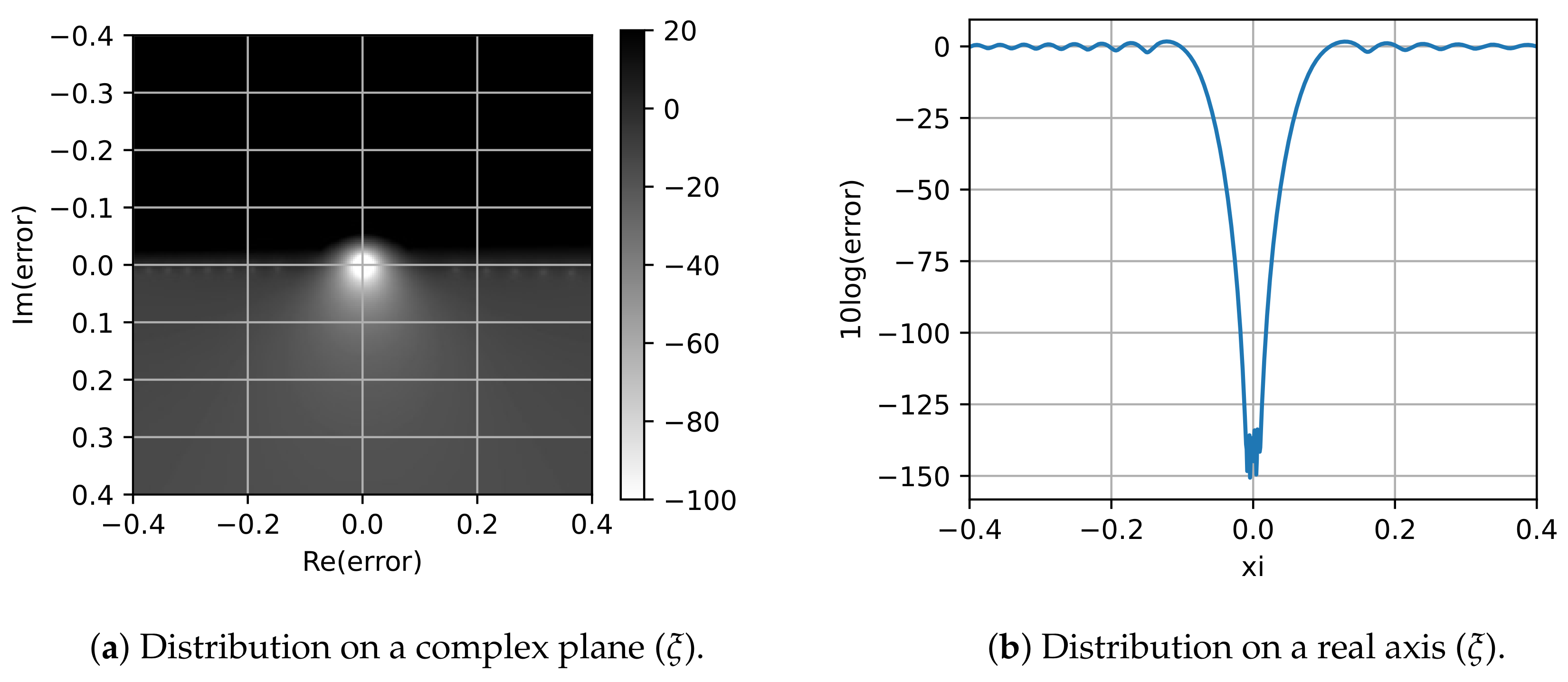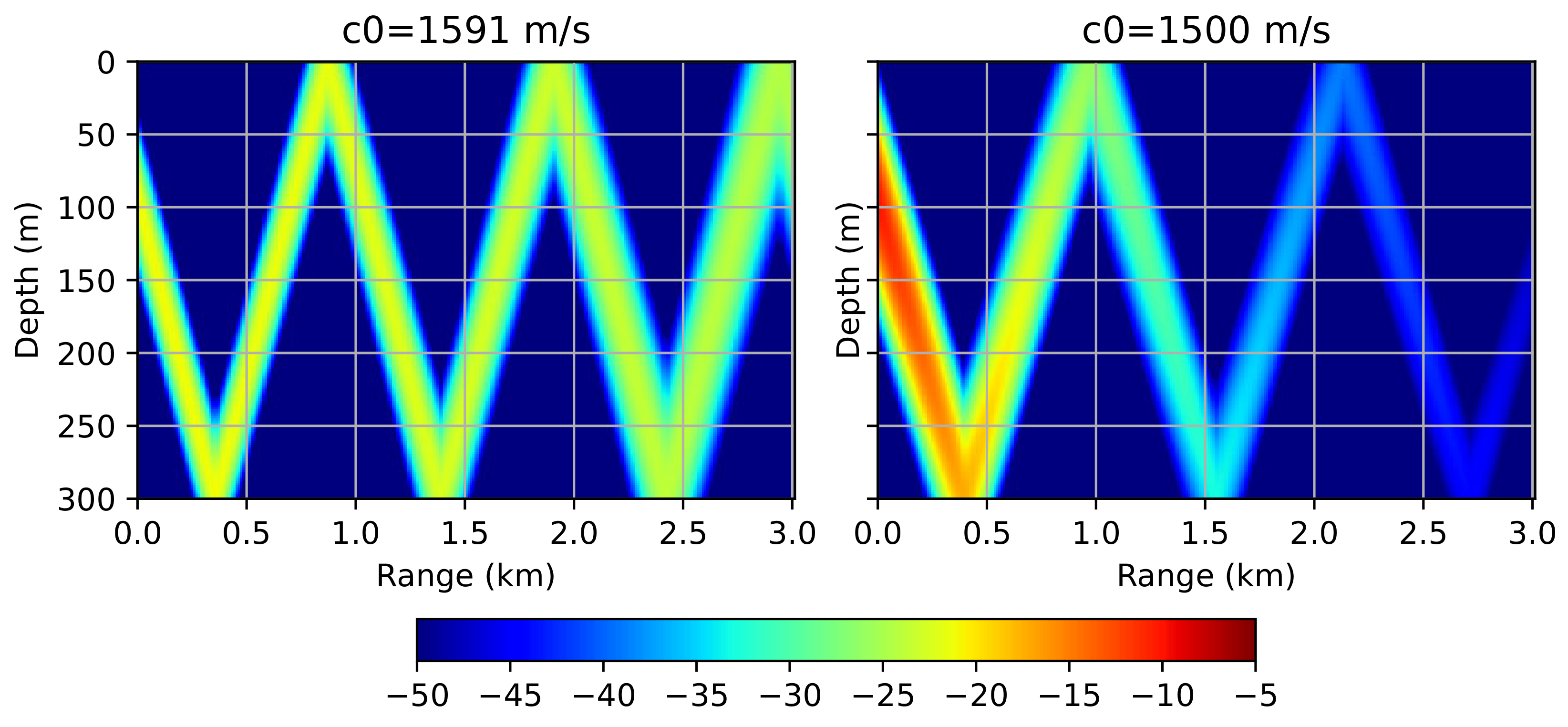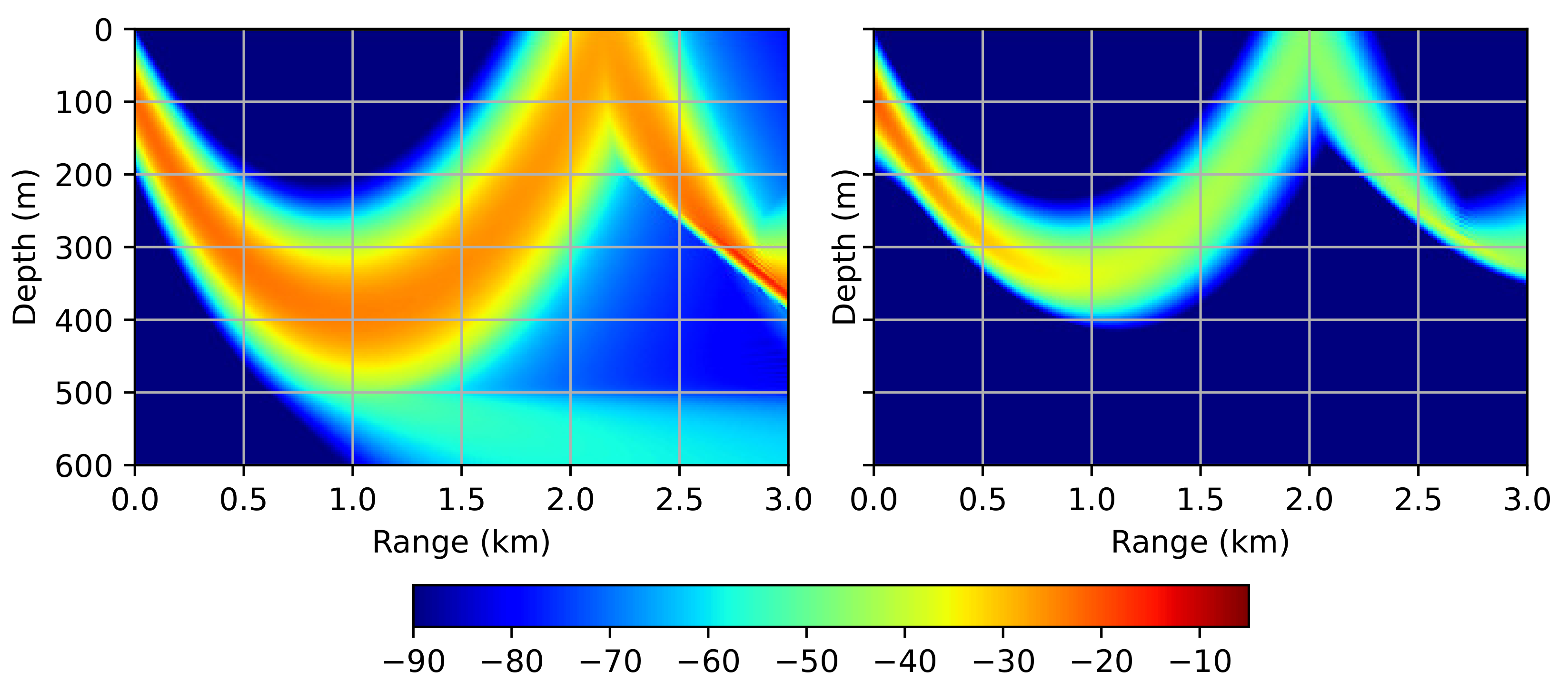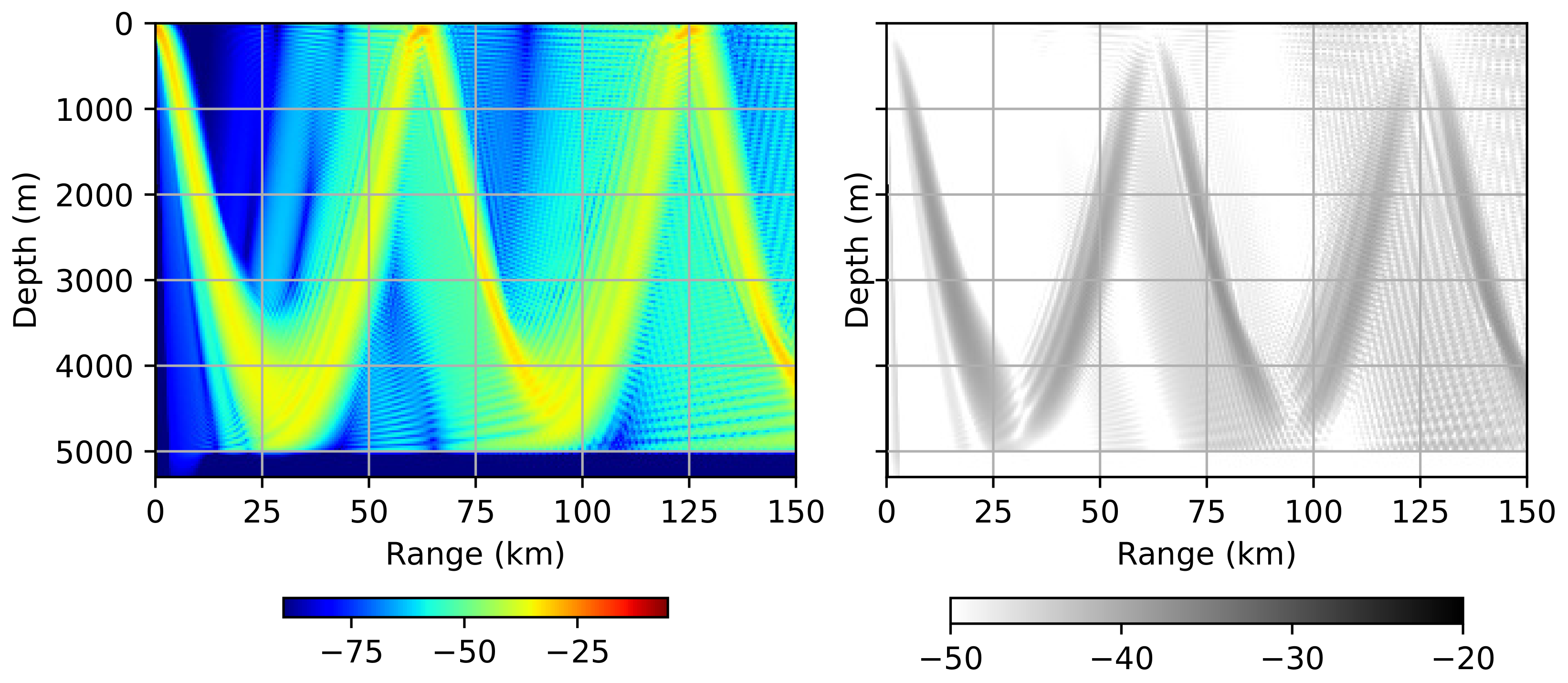Mesh Optimization for the Acoustic Parabolic Equation
Abstract
:1. Introduction
2. Mathematical Problem Statement and Definitions
3. Finite-Difference Padé Approximation
4. Computational Parameters Optimization Algorithm
4.1. Computational Grid Optimization
4.2. Reference Sound Speed Optimization
5. Optimization Results
5.1. Influence of the Maximum Distance from the Source
5.2. Effect of the Maximum Propagation Angle
5.3. Influence of the Approximation Order
5.4. Effect of the Inhomogeneous Sound Velocity Profile
5.5. Specifics of the Optimization Algorithm Implementation
6. Numerical Results
6.1. Waveguide with a Perfectly Reflective Bottom
6.2. Waveguide with an Inhomogeneous Refractive Index
6.3. Propagation in a Munk Profile
7. Conclusions
Funding
Institutional Review Board Statement
Informed Consent Statement
Data Availability Statement
Conflicts of Interest
References
- Petrov, P.; Katsnelson, B.; Li, Z. Modeling Techniques for Underwater Acoustic Scattering and Propagation (Including 3D Effects). J. Mar. Sci. Eng. 2022, 10, 1192. [Google Scholar] [CrossRef]
- Collins, M.D.; Siegmann, W.L. Parabolic Wave Equations with Applications; Springer: Cham, Switzerland, 2019. [Google Scholar]
- Fishman, L.; de Hoop, M.V.; Van Stralen, M.J.N. Exact constructions of square-root Helmholtz operator symbols: The focusing quadratic profile. J. Math. Phys. 2000, 41, 4881–4938. [Google Scholar] [CrossRef] [Green Version]
- Fishman, L.; McCoy, J.J. Derivation and application of extended parabolic wave theories. I. The factorized Helmholtz equation. J. Math. Phys. 1984, 25, 285–296. [Google Scholar] [CrossRef]
- Bamberger, A.; Engquist, B.; Halpern, L.; Joly, P. Higher order paraxial wave equation approximations in heterogeneous media. SIAM J. Appl. Math. 1988, 48, 129–154. [Google Scholar] [CrossRef]
- Hardin, R.H.; Tappert, F.D. Applications of the split-step Fourier method to the numerical solution of nonlinear and variable coefficient wave equations. SIAM Rev. 1973, 15, 4–23. [Google Scholar]
- Tappert, F.D. The parabolic approximation method. In Wave Propagation and Underwater Acoustics; Springer: Cham, Switzerland, 1977; pp. 224–287. [Google Scholar]
- Kozitskiy, S. Coupled-Mode Parabolic Equations for the Modeling of Sound Propagation in a Shallow-Water Waveguide with Weak Elastic Bottom. J. Mar. Sci. Eng. 2022, 10, 1355. [Google Scholar] [CrossRef]
- Chen, C.F. Reflection on Collins’ split-step Padé solution for the parabolic equation. J. Acoust. Soc. Am. 2022, 151, R3–R4. [Google Scholar] [CrossRef]
- Tu, H.; Wang, Y.; Ma, X.; Zhu, X. Applying the Chebyshev–Tau spectral method to solve the parabolic equation model of wide-angle rational approximation in ocean acoustics. J. Theor. Comput. Acoust. 2022, 30, 2150013. [Google Scholar] [CrossRef]
- Collins, M.D.; Evans, R.B. A two-way parabolic equation for acoustic backscattering in the ocean. J. Acoust. Soc. Am. 1992, 91, 1357–1368. [Google Scholar] [CrossRef]
- Mills, M.J.; Collins, M.D.; Lingevitch, J.F. Two-way parabolic equation techniques for diffraction and scattering problems. Wave Motion 2000, 31, 173–180. [Google Scholar] [CrossRef]
- Lin, Y.T.; Porter, M.B.; Sturm, F.; Isakson, M.J.; Chiu, C.S. Introduction to the special issue on three-dimensional underwater acoustics. J. Acoust. Soc. Am. 2019, 146, 1855–1857. [Google Scholar] [CrossRef] [Green Version]
- Petrov, P.S.; Ehrhardt, M.; Trofimov, M. On decomposition of the fundamental solution of the Helmholtz equation over solutions of iterative parabolic equations. Asymptot. Anal. 2022, 126, 215–228. [Google Scholar] [CrossRef]
- Petrov, P.S.; Ehrhardt, M.; Tyshchenko, A.G.; Petrov, P.N. Wide-angle mode parabolic equations for the modelling of horizontal refraction in underwater acoustics and their numerical solution on unbounded domains. J. Sound Vib. 2020, 484, 115526. [Google Scholar] [CrossRef]
- Jensen, F.B.; Kuperman, W.A.; Porter, M.B.; Schmidt, H. Computational Ocean Acoustics; Springer Science & Business Media: Berlin/Heidelberg, Germany, 2014. [Google Scholar]
- Porter, M.B. The KRAKEN Normal Mode Program; Technical Report; Naval Research Lab: Washington, DC, USA, 1992. [Google Scholar]
- Reddy, J.N. Introduction to the Finite Element Method; McGraw-Hill Education: New York, NY, USA, 2019. [Google Scholar]
- Kirkup, S.M. The Boundary Element Method in Acoustics; Integrated Sound Software; University of Central Lancashire: Preston, UK, 2007. [Google Scholar]
- Leontovich, M.A.; Fock, V.A. Solution of the problem of propagation of electromagnetic waves along the Earth’s surface by the method of parabolic equation. J. Phys. USSR 1946, 10, 13–23. [Google Scholar]
- Apaydin, G.; Ozgun, O.; Kuzuoglu, M.; Sevgi, L. A novel two-way finite-element parabolic equation groundwave propagation tool: Tests with canonical structures and calibration. IEEE Trans. Geosci. Remote Sens. 2011, 49, 2887–2899. [Google Scholar] [CrossRef]
- Levy, M.F. Transparent boundary conditions for parabolic equation solutions of radiowave propagation problems. IEEE Trans. Antennas Propag. 1997, 45, 66–72. [Google Scholar] [CrossRef]
- Lytaev, M.S. Nonlocal Boundary Conditions for Split-Step Padé Approximations of the Helmholtz Equation with Modified Refractive Index. IEEE Antennas Wirel. Propag. Lett. 2018, 17, 1561–1565. [Google Scholar] [CrossRef]
- Bekker, E.V.; Sewell, P.; Benson, T.M.; Vukovic, A. Wide-angle alternating-direction implicit finite-difference beam propagation method. J. Light. Technol. 2009, 27, 2595–2604. [Google Scholar] [CrossRef]
- Hadley, G.R. Wide-angle beam propagation using Padé approximant operators. Opt. Lett. 1992, 17, 1426–1428. [Google Scholar] [CrossRef]
- Schwendt, M.; Pötz, W. Transparent boundary conditions for higher-order finite-difference schemes of the Schrödinger equation in (1 + 1) D. Comput. Phys. Commun. 2020, 250, 107048. [Google Scholar] [CrossRef]
- Zlotnik, A.; Romanova, A. On a Numerov–Crank–Nicolson–Strang scheme with discrete transparent boundary conditions for the Schrödinger equation on a semi-infinite strip. Appl. Numer. Math. 2015, 93, 279–294. [Google Scholar] [CrossRef] [Green Version]
- Wang, J.; Wen, S.; Yang, M.; Shao, W. Practical finite difference method for solving multi-dimensional black-Scholes model in fractal market. Chaos Solitons Fractals 2022, 157, 111895. [Google Scholar] [CrossRef]
- Savović, S.; Drljača, B.; Djordjevich, A. A comparative study of two different finite difference methods for solving advection–diffusion reaction equation for modeling exponential traveling wave in heat and mass transfer processes. In Ricerche di Matematica; Springer: Cham, Switzerland, 2021; pp. 1–8. [Google Scholar]
- Samarskii, A.A.; Mikhailov, A.P. Principles of Mathematical Modelling: Ideas, Methods, Examples; Taylor and Francis: New York, NY, USA, 2002. [Google Scholar]
- Etter, P.C. Underwater Acoustic Modeling and Simulation; CRC Press: Boca Raton, FL, USA, 2018. [Google Scholar]
- Wang, D.; Huang, W.; Garcia, H.; Ratilal, P. Vocalization source level distributions and pulse compression gains of diverse baleen whale species in the Gulf of Maine. Remote Sens. 2016, 8, 881. [Google Scholar] [CrossRef] [Green Version]
- Dai, M.; Li, Y.; Ye, J.; Yang, K. Joint Tracking of Source and Environment Using Improved Particle Filtering in Shallow Water. J. Mar. Sci. Eng. 2021, 9, 1203. [Google Scholar] [CrossRef]
- Guarino, A.L.; Smith, K.B.; Godin, O.A. Bottom attenuation coefficient inversion based on the modal phase difference between pressure and vertical velocity from a single vector sensor. J. Theor. Comput. Acoust. 2022, 30, 2150008. [Google Scholar] [CrossRef]
- Erbe, C.; Marley, S.A.; Schoeman, R.P.; Smith, J.N.; Trigg, L.E.; Embling, C.B. The effects of ship noise on marine mammals a review. Front. Mar. Sci. 2019, 6, 606. [Google Scholar] [CrossRef] [Green Version]
- Manul’chev, D.; Tyshchenko, A.; Fershalov, M.; Petrov, P. Estimating Sound Exposure Levels Due to a Broadband Source over Large Areas of Shallow Sea. J. Mar. Sci. Eng. 2022, 10, 82. [Google Scholar] [CrossRef]
- Ocean Acoustics Library. 2023. Available online: https://oalib-acoustics.org/ (accessed on 23 January 2023).
- Lytaev, M.S. Automated Selection of the Computational Parameters for the Higher-Order Parabolic Equation Numerical Methods. Int. Conf. Comput. Sci. Appl. 2020, 12249, 296–311. [Google Scholar]
- Sanders, W.M.; Collins, M.D. Nonuniform depth grids in parabolic equation solutions. J. Acoust. Soc. Am. 2013, 133, 1953–1958. [Google Scholar] [CrossRef]
- Brooke, G.H.; Thomson, D.J. Non-local boundary conditions for high-order parabolic equation algorithms. Wave Motion 2000, 31, 117–129. [Google Scholar] [CrossRef]
- Arnold, A.; Ehrhardt, M. Discrete transparent boundary conditions for wide angle parabolic equations in underwater acoustics. J. Comput. Phys. 1998, 145, 611–638. [Google Scholar] [CrossRef] [Green Version]
- Yevick, D.; Thomson, D.J. A hybrid split-step/finite-difference PE algorithm for variable-density media. J. Acoust. Soc. Am. 1997, 101, 1328–1335. [Google Scholar] [CrossRef]
- Levy, M.F. Parabolic Equation Methods for Electromagnetic Wave Propagation; The Institution of Electrical Engineers: London, UK, 2000. [Google Scholar]
- Lytaev, M.S. Rational interpolation of the one-way Helmholtz propagator. J. Comput. Sci. 2022, 58, 101536. [Google Scholar] [CrossRef]
- Brekhovskikh, L.M. Waves in Layered Media; Academic Press: Cambridge, MA, USA, 1980. [Google Scholar]
- Baker, G.A.; Graves-Morris, P. Padé Approximants; Cambridge University Press: Cambridge, UK, 1996; Volume 59. [Google Scholar]
- Collins, M.D. A split-step Padé solution for the parabolic equation method. J. Acoust. Soc. Am. 1993, 93, 1736–1742. [Google Scholar] [CrossRef]
- Lee, D.; Schultz, M.H. Numerical Ocean Acoustic Propagation in Three Dimensions; World Scientific: Singapore, 1995. [Google Scholar]
- Lytaev, M.S. PyWaveProp. Wave Propagation Library for Python 3. 2023. Saint Petersburg. Available online: https://github.com/mikelytaev/wave-propagation (accessed on 23 January 2023).








| (m) | m/s | m/s | Gain | ||||
|---|---|---|---|---|---|---|---|
| (m) | (m) | (m) | (m) | ||||
| 1000 | 20 | 50 | 2.5 | ||||
| 2000 | 20 | 40 | 2.2 | ||||
| 5000 | 10 | 40 | 4.5 | ||||
| 10,000 | 10 | 40 | 4.0 | ||||
| 50,000 | 10 | 30 | 3.75 | ||||
| () | m/s | m/s | Gain | ||||
|---|---|---|---|---|---|---|---|
| (m) | (m) | (m) | (m) | ||||
| 5 | 100 | 100 | 1.0 | ||||
| 10 | 100 | 100 | 1.0 | ||||
| 20 | 40 | 100 | 2.5 | ||||
| 30 | 10 | 40 | 4.5 | ||||
| 45 | 6 | 20 | 4.2 | ||||
| 60 | 1 | 10 | 20 | ||||
| 70 | - | - | 10 | - | |||
| 80 | - | - | 9 | - | |||
| 85 | - | - | 8 | - | |||
| Padé Order | 2nd Order | 4th Order | Gain | ||||
|---|---|---|---|---|---|---|---|
| (m) | (m) | (m) | (m) | ||||
| [1/1] | - | - | - | - | - | - | - |
| [2/3] | 3 | 0.006 | 166.6 | 4 | 0.08 | 9.4 | 17.7 |
| [3/4] | 9 | 0.006 | 74.1 | 10 | 0.1 | 4.0 | 18.5 |
| [6/7] | 30 | 0.006 | 38.8 | 40 | 0.09 | 1.9 | 20.4 |
| [7/8] | 50 | 0.005 | 32.0 | 50 | 0.1 | 1.6 | 20 |
| [8/8] | 50 | 0.006 | 26.6 | 50 | 0.1 | 1.6 | 16.6 |
| (m) | m/s | m/s | Gain | ||||
|---|---|---|---|---|---|---|---|
| (m) | (m) | (m) | (m) | ||||
| 1000 | 10 | 0.1 | [−0.31, 0.0] | 30 | 0.1 | [−0.16, 0.16] | 3 |
| 2000 | 10 | 0.1 | 30 | 0.1 | 3 | ||
| 5000 | 10 | 0.08 | 30 | 0.09 | 3.375 | ||
| 10,000 | 10 | 0.06 | 30 | 0.07 | 3.5 | ||
| 50,000 | 10 | 0.04 | 20 | 0.05 | 2.5 | ||
Disclaimer/Publisher’s Note: The statements, opinions and data contained in all publications are solely those of the individual author(s) and contributor(s) and not of MDPI and/or the editor(s). MDPI and/or the editor(s) disclaim responsibility for any injury to people or property resulting from any ideas, methods, instructions or products referred to in the content. |
© 2023 by the author. Licensee MDPI, Basel, Switzerland. This article is an open access article distributed under the terms and conditions of the Creative Commons Attribution (CC BY) license (https://creativecommons.org/licenses/by/4.0/).
Share and Cite
Lytaev, M. Mesh Optimization for the Acoustic Parabolic Equation. J. Mar. Sci. Eng. 2023, 11, 496. https://doi.org/10.3390/jmse11030496
Lytaev M. Mesh Optimization for the Acoustic Parabolic Equation. Journal of Marine Science and Engineering. 2023; 11(3):496. https://doi.org/10.3390/jmse11030496
Chicago/Turabian StyleLytaev, Mikhail. 2023. "Mesh Optimization for the Acoustic Parabolic Equation" Journal of Marine Science and Engineering 11, no. 3: 496. https://doi.org/10.3390/jmse11030496
APA StyleLytaev, M. (2023). Mesh Optimization for the Acoustic Parabolic Equation. Journal of Marine Science and Engineering, 11(3), 496. https://doi.org/10.3390/jmse11030496






